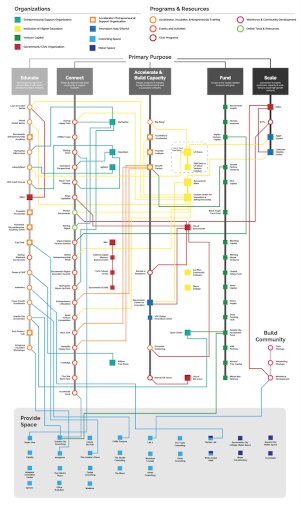Building Startup Communities is the Way to Economic Growth and Recovery
Economies are hurting. Even prior to COVID-19, healthy economies were limited to a few metro areas. The pandemic has accelerated and exacerbated the situation. All across the country, communities need to jump start and rebuild their economies. How?
Research has shown that most new jobs come from young businesses. And yet, many economic policies continue to focus on attracting big businesses. It’s time for a radical rethink in how we do economic development. We need to shift our economic development strategies to startup community building, (also referred to as entrepreneurial ecosystem building), as the primary approach to rebuilding our cities’ economies.
“Those places that fail to boldly and immediately invest in startup ecosystems, and thus fail to produce startups, will experience economic stagnation.”
The research and evidence supporting the impact and value of startup community building is strong. The logic is simple and straightforward. There is a simple theory of change for civic, business, and community leaders to adopt.
- Economic growth or expansion (or recovery) depends on business dynamism
- Startups are key to business dynamism and strong economic growth
- Startups and entrepreneurs need ecosystems and communities of support to be successful
- Ecosystems need to intentionally build and nurture a startup community
Let’s explore each of these.
Economic growth or stagnation depends on business dynamism
Economic dynamism, which tracks the rate of new business starts, is a key indicator of economic health. Economic data shows that as the rates of new startups fall, economic growth falls as well.
The startup rate in the U.S. has continuously fallen since the late 1970s and the Great Recession exacerbated the trend, damaging business dynamism and as a result, economies. In their paper, Dynamism in Retreat, the Economic Innovation Group (EIG) found, “The Great Recession touched off a true collapse in new firm starts. It marked the first time on record that companies were dying faster than they were being born in the United States.”
Fewer startups leads to less productivity growth. The New York Times article Where Are the Start-Ups? Loss of Dynamism Is Impeding Growth, found that, “Fewer start-ups mean fewer new ideas and fewer young, productive businesses to replace older, less productive ones. Researchers have found that the decline in companies entering the market since 1980 has trimmed productivity growth by about 3.1 percent.”
Conversely, higher rates of business dynamism are associated with economic growth. In the Dynamism in Retreat article, EIG found that, “High rates of dynamism are associated with economic expansion. Without it, an economy trends towards stagnation.”
Startups are key to economic dynamism and strong economic growth
The key ingredient to increasing the rate of economic dynamism is startups. In a 2017 report, How the Startup Economy is Spreading Across the Country — and How It Can Be Accelerated, the Progressive Policy Institute (PPI) and TechNet found “Recent research from academic economists suggests that regions that produce more high-quality startups show better economic performance.” The report further found that a “doubling of entrepreneurial quality in a region predicted an increase of 6.8% in GDP 11 years in the future.”
Since the mid-1990s researches have been finding that new and young businesses are the main driver in new job creation. The 2014 Kauffman Foundation report, The Importance of Young Firms for Economic Growth, found that “New businesses account for nearly all net new job creation and almost 20 percent of gross job creation.” The report further finds that, “Companies less than one year old have created an average of 1.5 million jobs per year over the past three decades.”
The key takeaway from a Kauffman Foundation report is that, not only are entrepreneurs and young companies the key drivers of economic growth, but that entrepreneurship is vital to jobs and economic progress. The best way to revitalize a city’s economy is through entrepreneurship and startup ecosystem building.
The report from Kauffman isn’t an outlier. The paper, The Role of Entrepreneurship in US Job Creation and Economic Dynamism, found that “Business startups account for about 20 percent of US gross (total) job creation while high-growth businesses (which are disproportionately young) account for almost 50 percent of gross job creation.”
Startups and entrepreneurs need communities of support to be successful
While startups are key to job creation and economic growth, they can’t succeed on their own. They need a community of support.
Startup Genome provides data-driven insights to inform innovation policy leaders and help them focus their actions. In their Global Startup Ecosystem Report 2017, they found that, “Early-stage startups are highly dependent on their surrounding startup ecosystem, and so if we can create healthier startup ecosystems, we can generate more successful startups.”
The report goes on to recommend what communities should do to build stronger economies. “Startups are the key vehicle by which regions and their citizens can take advantage of technological change, and startups depend on strong ecosystems…Those places that fail to boldly and immediately invest in startup ecosystems, and thus fail to produce startups, will experience economic stagnation…. To mitigate that [economic inequality], countries and regions need to focus on building stronger startup ecosystems.”
Ecosystems need to intentionally build and nurture a startup community
In order for communities to successfully support their startups there needs to be alignment and collaboration among the actors in the community.
Daniel Isenberg is an early thought leader in the entrepreneurial ecosystem approach to economic development. In his 2011 paper, The Entrepreneurship Ecosystem Strategy as a New Paradigm for Economic Policy: Principles for Cultivating Entrepreneurship, he outlines multiple principles in arguing the case for entrepreneurship ecosystem strategies. Among these principles, Isenberg argues, is the need to intervene holistically with a comprehensive ecosystem perspective.
“The need for an ecosystem strategy stems from the observation that when we see societies in which entrepreneurship occurs with any regularity or is self-sustaining, we see a unique, complex environment or ecosystem has evolved.” He goes on to say, “Entrepreneurship is about profit-seeking ambition, and when successful, uniquely enriches the overall economy and society. Because of the spillovers, the task of the policy maker and public leader is to create a virtuous cycle of entrepreneurship. The shortest path to creating this virtuous cycle is to directly create, enhance, cultivate, evolve — a geographically concentrated ecosystem that is conducive to entrepreneurship and its success.”
Isenberg concludes that the shortest path to economic growth is “through the deliberate and informed cultivation of an entrepreneurship ecosystem.”
Building and nurturing a startup community takes a focused and collaborative effort. Research from the Agile Strategy Lab at Purdue University, demonstrated that “A dynamic entrepreneurial ecosystem emerges from a portfolio of complex, interconnected collaborations in the following strategic focus areas: 1) talent development; 2) entrepreneurial support networks; 3) quality connected places; and 4) new narratives; and 5) planned activities to increase intentional interactions and collaborative skills.”
The evidence is clear. If communities want to build, and now rebuild, our economies, they need to invest time and resources into building the startup communities that help entrepreneurs thrive.













